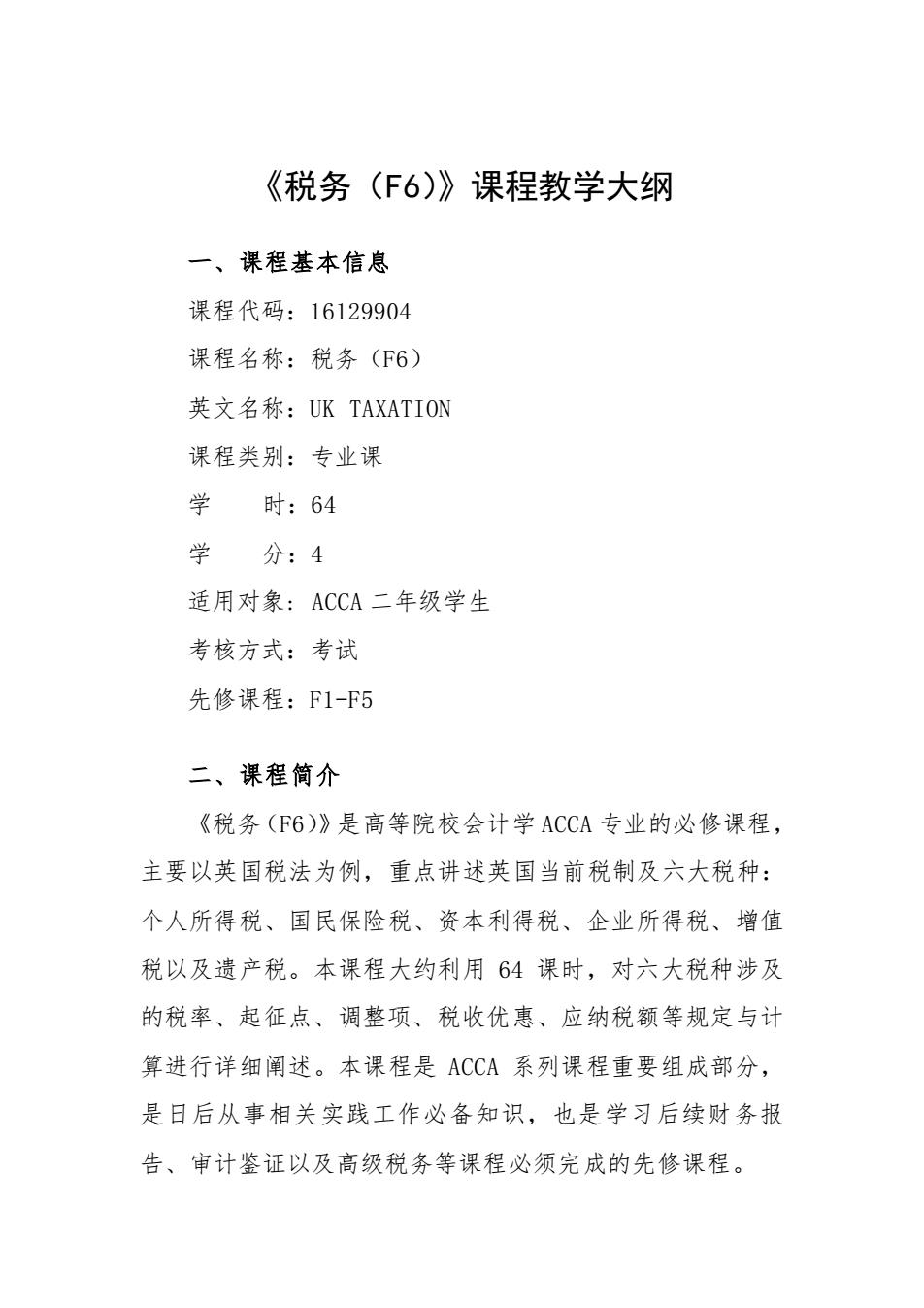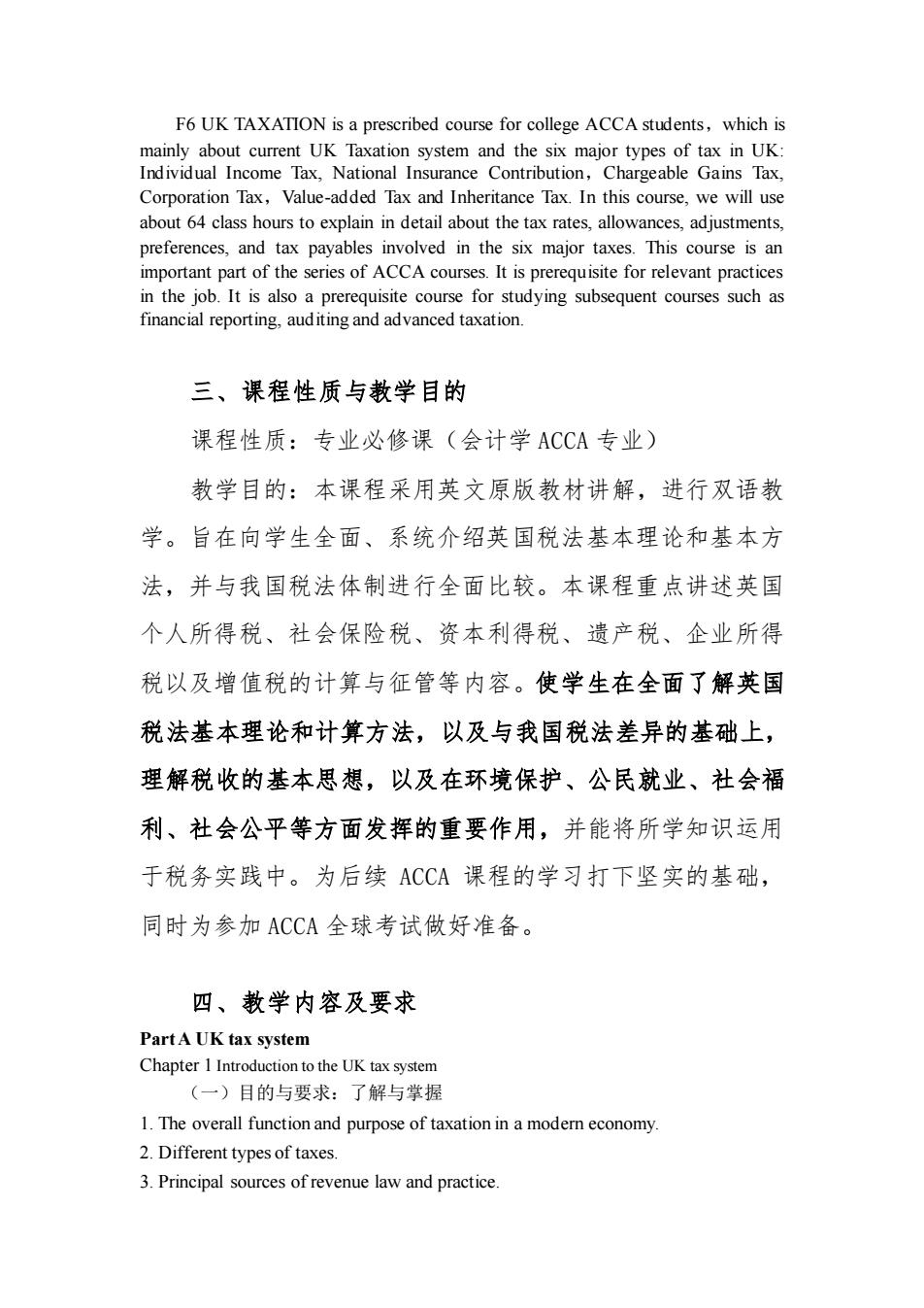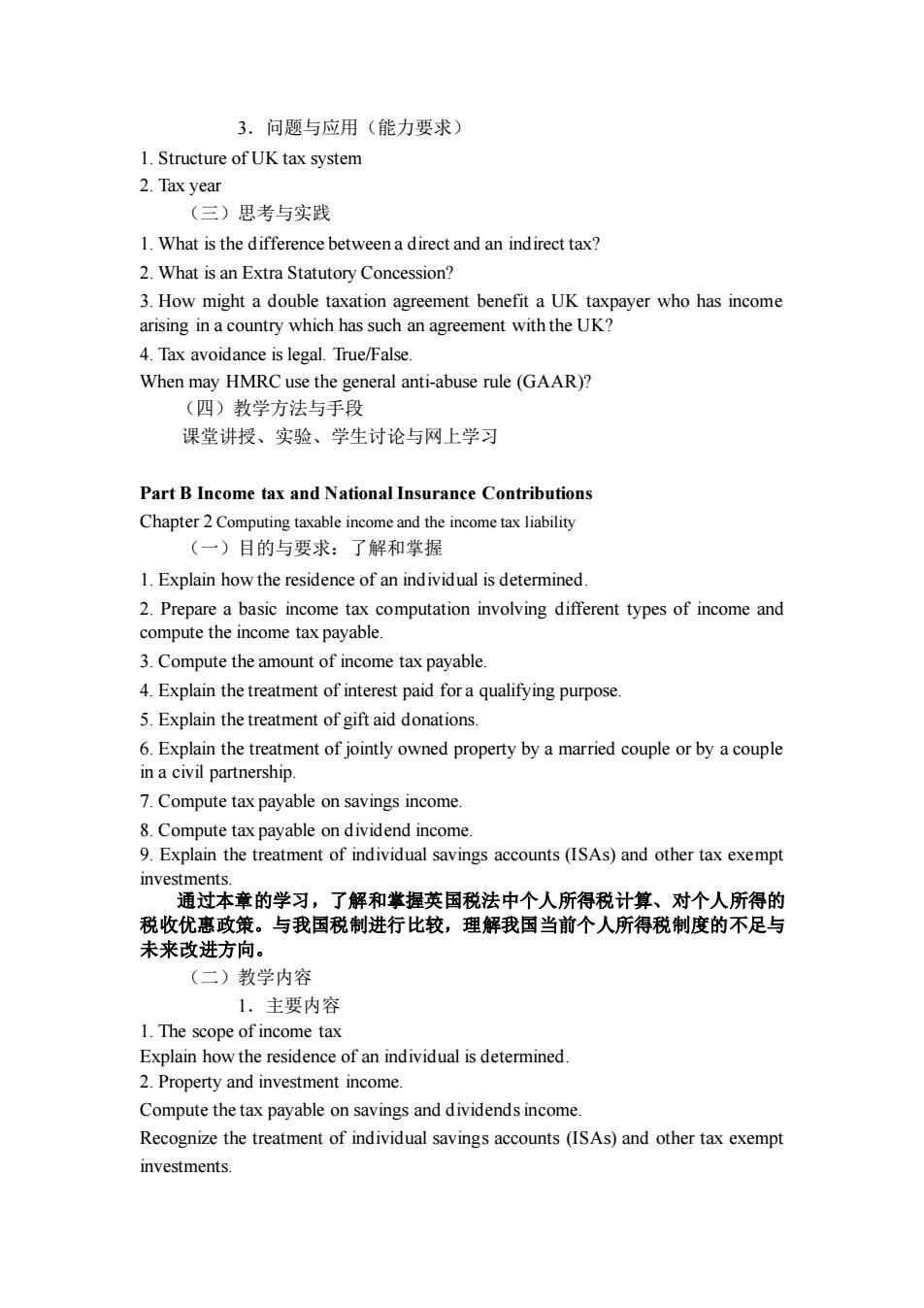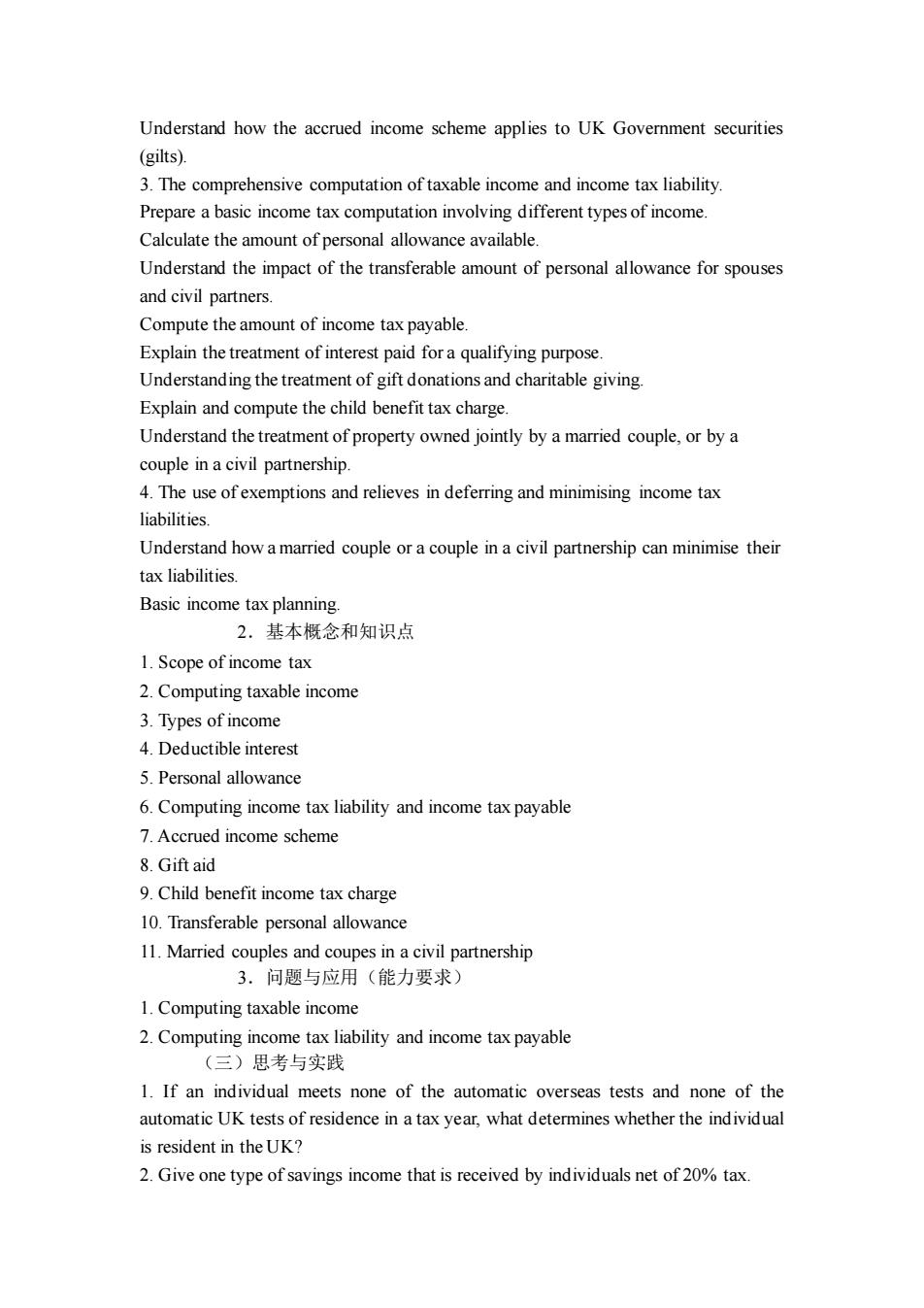
《税务(F6)》课程教学大纲 一、课程基本信息 课程代码:16129904 课程名称:税务(F6) 英文名称:UK TAXATION 课程类别:专业课 学时:64 学分:4 适用对象:ACCA二年级学生 考核方式:考试 先修课程:F1-F5 二、课程筒介 《税务(F6)》是高等院校会计学ACCA专业的必修课程, 主要以英国税法为例,重点讲述英国当前税制及六大税种: 个人所得税、国民保险税、资本利得税、企业所得税、增值 税以及遗产税。本课程大约利用64课时,对六大税种涉及 的税率、起征点、调整项、税收优惠、应纳税额等规定与计 算进行详细阐述。本课程是ACCA系列课程重要组成部分, 是日后从事相关实践工作必备知识,也是学习后续财务报 告、审计鉴证以及高级税务等课程必须完成的先修课程
《税务(F6)》课程教学大纲 一、课程基本信息 课程代码:16129904 课程名称:税务(F6) 英文名称:UK TAXATION 课程类别:专业课 学 时:64 学 分:4 适用对象: ACCA 二年级学生 考核方式:考试 先修课程:F1-F5 二、课程简介 《税务(F6)》是高等院校会计学 ACCA 专业的必修课程, 主要以英国税法为例,重点讲述英国当前税制及六大税种: 个人所得税、国民保险税、资本利得税、企业所得税、增值 税以及遗产税。本课程大约利用 64 课时,对六大税种涉及 的税率、起征点、调整项、税收优惠、应纳税额等规定与计 算进行详细阐述。本课程是 ACCA 系列课程重要组成部分, 是日后从事相关实践工作必备知识,也是学习后续财务报 告、审计鉴证以及高级税务等课程必须完成的先修课程

F6 UK TAXATION is a prescribed course for college ACCA students,which is min bot cumren IK Tion ystem nd the six men UK Corporation Tax,Value-added Tax and Inheritance Tax.In this course,we will use about 64 class hours to explain in detail about the tax rates,allowances,adjustments, preferences,and tax payables involved in the six major taxes.This course is an tof the series of ACCA courses.It is prerequisite for relevant practices in the job.It is also a for studying subsequent courses such as financial reporting,auditing and advanced taxation. 三、课程性质与教学目的 课程性质:专业必修课(会计学ACCA专业) 教学目的:本课程采用英文原版教材讲解,进行双语教 学。旨在向学生全面、系统介绍英国税法基本理论和基本方 法,并与我国税法体制进行全面比较。本课程重点讲述英国 个人所得税、社会保险税、资本利得税、遗产税、企业所得 税以及增值税的计算与征管等内容。使学生在全面了解英国 税法基本理论和计算方法,以及与我国税法差异的基础上, 理解税收的基本思想,以及在环境保护、公民就业、社会福 利、社会公平等方面发挥的重要作用,并能将所学知识运用 于税务实践中。为后续ACCA课程的学习打下坚实的基础, 同时为参加ACCA全球考试做好准备。 四、教学内容及要求 Part A UK tax system Chapter 1 Introduction to the UK tax system (一)目的与要求:了解与掌握 1.The overall function and purpose of taxation in a modern economy 2.Different typesof taxes. 3.Principal sources of revenue law and practice
F6 UK TAXATION is a prescribed course for college ACCA students,which is mainly about current UK Taxation system and the six major types of tax in UK: Individual Income Tax, National Insurance Contribution,Chargeable Gains Tax, Corporation Tax,Value-added Tax and Inheritance Tax. In this course, we will use about 64 class hours to explain in detail about the tax rates, allowances, adjustments, preferences, and tax payables involved in the six major taxes. This course is an important part of the series of ACCA courses. It is prerequisite for relevant practices in the job. It is also a prerequisite course for studying subsequent courses such as financial reporting, auditing and advanced taxation. 三、课程性质与教学目的 课程性质:专业必修课(会计学 ACCA 专业) 教学目的:本课程采用英文原版教材讲解,进行双语教 学。旨在向学生全面、系统介绍英国税法基本理论和基本方 法,并与我国税法体制进行全面比较。本课程重点讲述英国 个人所得税、社会保险税、资本利得税、遗产税、企业所得 税以及增值税的计算与征管等内容。使学生在全面了解英国 税法基本理论和计算方法,以及与我国税法差异的基础上, 理解税收的基本思想,以及在环境保护、公民就业、社会福 利、社会公平等方面发挥的重要作用,并能将所学知识运用 于税务实践中。为后续 ACCA 课程的学习打下坚实的基础, 同时为参加 ACCA 全球考试做好准备。 四、教学内容及要求 Part A UK tax system Chapter 1 Introduction to the UK tax system (一)目的与要求:了解与掌握 1. The overall function and purpose of taxation in a modern economy. 2. Different types of taxes. 3. Principal sources of revenue law and practice

4.Tax avoidance and tax evasion 了解英国税制基本概况,了解税收基本思想、经济作用。并通过对中、英 两国税制的比较,认识我国当前税制的优点及不足,以及未来可能的改进方向。 (二)教学内容 1.主要内容 THE UK TAX SYSTEM AND ITS ADMINISTRATION 1.The overall function and purpose of taxation in a modern economy b)Expain the and ndre )Identify the different types of capital and revenue tax 2.Principal sources of revenue law and practice a)Describe the overall structure of the UK tax system. b)State the different sources of revenue law )Describe the organisation HM Revenue&Customs(HMRC)and its termsof referenc )Explain between tax avoidance and tax evasion,and the purposes of the Genera Anti-Abuse Rule(GAAR). e)Appreciate the interaction of the UK tax system with that of other tax jurisdictions. d appreciate the need for double taxation agreements. gEplainthenedforanehicalandprofcsionlapproach The ym sment an the making of retu a)Explain and apply the features of the self assessment system as it applies to individuals b)Explain and apply the features of the self assessment system as it applies to companies, including the use of iXBRL 4.The time limits for the submission of information,claims and payment of tax,including p间yments n a)Recognise the time limits that apply to the filing of returns and the making of claims b)Recognise the due dates for the payment of tax under the self-assessment system.and compute payments on account and balancing payments/repayments for individuals. e)Explain how large companies are required to account for corporation tax on a quarterly basis 5.The procedures relating to compliance checks,appeals and disputes a)Explain the circumstances in which HM Revenue&Customs can make a compliance check into a self-assessment tax return. b)Explain the procedures for dealing with appeals and First and Upper Tier Tribunals. 6.Penalties for a)Calculate late pavment interest and state the penalties that can be charged 2.基本概念和知识点 1.The overall function and purpose of taxation in a modern economy 2.Different types of taxes. 3.Principal sources ofrevenue law and practice 4.Tax avoidance and tax evasion
4. Tax avoidance and tax evasion. 了解英国税制基本概况,了解税收基本思想、经济作用。并通过对中、英 两国税制的比较,认识我国当前税制的优点及不足,以及未来可能的改进方向。 (二)教学内容 1.主要内容 THE UK TAX SYSTEM AND ITS ADMINISTRATION 1. The overall function and purpose of taxation in a modern economy a) Describe the purpose (economic, social etc) of taxation in a modern economy. b) Explain the difference between direct and indirect taxation. c) Identify the different types of capital and revenue tax. 2. Principal sources of revenue law and practice a) Describe the overall structure of the UK tax system. b) State the different sources of revenue law. c) Describe the organisation HM Revenue & Customs (HMRC) and its terms of reference. d) Explain the difference between tax avoidance and tax evasion, and the purposes of the General Anti-Abuse Rule (GAAR). e) Appreciate the interaction of the UK tax system with that of other tax jurisdictions. f) Appreciate the need for double taxation agreements. g) Explain the need for an ethical and professional approach. 3. The systems for self-assessment and the making of returns a) Explain and apply the features of the self assessment system as it applies to individuals. b) Explain and apply the features of the self assessment system as it applies to companies, including the use of iXBRL. 4. The time limits for the submission of information, claims and payment of tax, including payments on account a) Recognise the time limits that apply to the filing of returns and the making of claims. b) Recognise the due dates for the payment of tax under the self-assessment system, and compute payments on account and balancing payments/repayments for individuals. c) Explain how large companies are required to account for corporation tax on a quarterly basis and compute the quarterly instalment payments. d) List the information and records that taxpayers need to retain for tax purposes. 5. The procedures relating to compliance checks, appeals and disputes a) Explain the circumstances in which HM Revenue & Customs can make a compliance check into a self-assessment tax return. b) Explain the procedures for dealing with appeals and First and Upper Tier Tribunals. 6. Penalties for non-compliance a) Calculate late payment interest and state the penalties that can be charged. 2.基本概念和知识点 1.The overall function and purpose of taxation in a modern economy. 2.Different types of taxes. 3.Principal sources of revenue law and practice. 4. Tax avoidance and tax evasion

3.问题与应用(能力要求) 1.Structure of UK tax system 2.Tax yea (三)思考与实践 1.What is the difference betweena direct and an indirect tax? 2.What is an Extra Statutory Concession? 3.How might a double taxation agreement benefit a UK taxpayer who has income arising in a country which has such an agreement with the UK? 4.Tax avoidance is legal.True/False. When may HMRC use the general anti-abuse rule(GAAR)? (四)教学方法与手段 课堂讲授、实验、学生讨论与网上学习 Part B Income tax and National Insurance Contributions Chapter 2 Computing taxable income and the income tax liability (一)目的与要求:了解和掌握 1.Explain how the residence of an individual is determined. 2.Prepare a basic income tax computation involving different types of income and compute the income tax payable. 3.Compute the amount of income tax payable 4.Explain the treatment of interest paid for a qualifying purpose. 5.Explain the treatment of gift aid donations. 6.Explain the treatment of jointly owned property by a married couple or by a couple ina civil partnership 7.Compute tax payable on savings income. 8.Compute tax payable on dividend income. 9.Explain the treatment of individual savings accounts (ISAs)and other tax exempt investments 通过本章的学习,了解和掌握英国税法中个人所得税计算、对个人所得的 税收优惠政策。与我国税制进行比较,理解我国当前个人所得税制度的不足与 未来改进方向 (二)教学内容 1.主要内容 1.The scope of income tax Explain how the residence of an individual is determined. 2.Property and investment income Compute the tax payable on savings and dividends income. Recognize the treatment of individual savings accounts (ISAs)and other tax exempt investments
3.问题与应用(能力要求) 1. Structure of UK tax system 2. Tax year (三)思考与实践 1. What is the difference between a direct and an indirect tax? 2. What is an Extra Statutory Concession? 3. How might a double taxation agreement benefit a UK taxpayer who has income arising in a country which has such an agreement with the UK? 4. Tax avoidance is legal. True/False. When may HMRC use the general anti-abuse rule (GAAR)? (四)教学方法与手段 课堂讲授、实验、学生讨论与网上学习 Part B Income tax and National Insurance Contributions Chapter 2 Computing taxable income and the income tax liability (一)目的与要求:了解和掌握 1. Explain how the residence of an individual is determined. 2. Prepare a basic income tax computation involving different types of income and compute the income tax payable. 3. Compute the amount of income tax payable. 4. Explain the treatment of interest paid for a qualifying purpose. 5. Explain the treatment of gift aid donations. 6. Explain the treatment of jointly owned property by a married couple or by a couple in a civil partnership. 7. Compute tax payable on savings income. 8. Compute tax payable on dividend income. 9. Explain the treatment of individual savings accounts (ISAs) and other tax exempt investments. 通过本章的学习,了解和掌握英国税法中个人所得税计算、对个人所得的 税收优惠政策。与我国税制进行比较,理解我国当前个人所得税制度的不足与 未来改进方向。 (二)教学内容 1.主要内容 1. The scope of income tax Explain how the residence of an individual is determined. 2. Property and investment income. Compute the tax payable on savings and dividends income. Recognize the treatment of individual savings accounts (ISAs) and other tax exempt investments

Understand how the accrued income scheme applies to UK Goverment securities (gilts). 3.The comprehensive computation of taxable income and income tax liability Prepare a basic income tax computation involving different types of income. Calculate the amount of personal allowance available Understand the impact of the transferable amount of personal allowance for spouses and civil partners Compute the amount of income tax payable. Explain the treatment of interest paid for a qualifying purpose. Understanding the treatment of gift donations and charitable giving. Explain and compute the child benefit tax charge. Understand the treatment of property owned jointly by a married couple.or by a couple in a civil partnership. 4.The use ofexemptions and relieves in deferring and minimising income tax iabilities. Understand how a married couple or a couple in a civil partnership can minimise their tax liabilities Basic income tax planning 2.基本概念和知识点 1.Scope of income tax 2.Computing taxable income 3.Types of income 4.Deductible interes 5.Personal allowance 6.Computing income tax liability and income tax payable 7.Accrued income scheme 8 Gift aid 9.Child benefit income tax charge 10.Transferable personal allowance 11.Married couples and coupes in a civil partnership 3。问题与应用(能力要求) 1.Computing taxable income 2.Computing income tax liability and income tax payable (三)思考与实践 1.If an individual meets none of the automatic overseas tests and none of the automatic UK tests of residence in a tax year,what determines whether the individual is resident in the UK? 2.Give one type of savings income that is received by individuals net of 20%tax
Understand how the accrued income scheme applies to UK Government securities (gilts). 3. The comprehensive computation of taxable income and income tax liability. Prepare a basic income tax computation involving different types of income. Calculate the amount of personal allowance available. Understand the impact of the transferable amount of personal allowance for spouses and civil partners. Compute the amount of income tax payable. Explain the treatment of interest paid for a qualifying purpose. Understanding the treatment of gift donations and charitable giving. Explain and compute the child benefit tax charge. Understand the treatment of property owned jointly by a married couple, or by a couple in a civil partnership. 4. The use of exemptions and relieves in deferring and minimising income tax liabilities. Understand how a married couple or a couple in a civil partnership can minimise their tax liabilities. Basic income tax planning. 2.基本概念和知识点 1. Scope of income tax 2. Computing taxable income 3. Types of income 4. Deductible interest 5. Personal allowance 6. Computing income tax liability and income tax payable 7. Accrued income scheme 8. Gift aid 9. Child benefit income tax charge 10. Transferable personal allowance 11. Married couples and coupes in a civil partnership 3.问题与应用(能力要求) 1. Computing taxable income 2. Computing income tax liability and income tax payable (三)思考与实践 1. If an individual meets none of the automatic overseas tests and none of the automatic UK tests of residence in a tax year, what determines whether the individual is resident in the UK? 2. Give one type of savings income that is received by individuals net of 20% tax